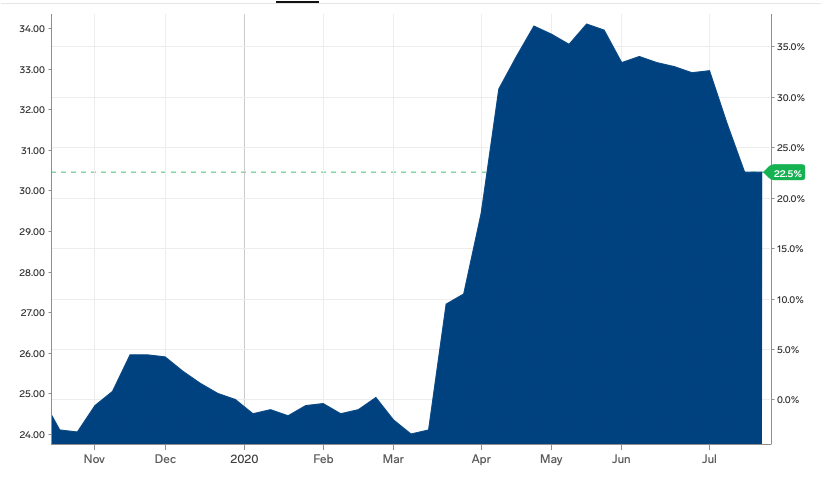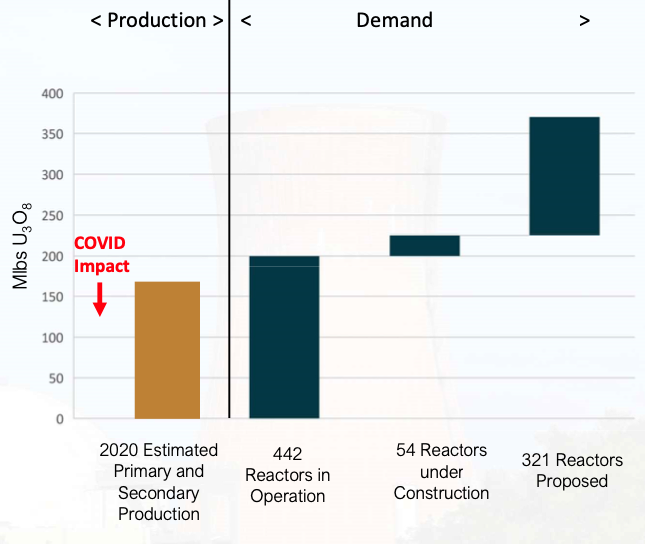Uranium price set to triple on growing supply deficit: miner

Pic: Yuichiro Chino / Moment via Getty Images
- Miner predicts uranium price could soar as supply deficit grows in coming years
- At current prices ‘there is no incentive to build new mines’
- Uranium supply shortfall could reach 50 million pounds this year
Uranium prices could triple to $US100 per pound (A$140/pound) on a looming supply crisis for the generation fuel just as a raft of new nuclear plants enter service this coming decade.
After many years of being side-lined by governments, nuclear power is starting to receive more attention for its low emissions, reliability, and relatively low cost as a generation fuel.
“Nuclear power has been pushed aside for many years,” Marenica Energy (ASX:MEY) chief executive Murray Hill told Stockhead.
“However more recently nuclear power is being discussed as it does not have any greenhouse gas emissions and it provides reliable baseload electricity around the clock,” he said.
His company has the largest holding of uranium tenements in Namibia, south-west Africa, and some additional projects in Australia’s Northern Territory and Western Australia.
“Namibia has a well established uranium industry and is very supportive of uranium mining, it is a good jurisdiction to be in,” said Hill.
“There are two operating uranium mines in Namibia, with two more on care and maintenance due to the low uranium price,” he added.
Marenica Energy is exploring for uranium in palaeochannels on its Namibia tenements with success at Koppies and Hirabeb , in an area that contains 230 million-pound of palaeochannel resources.
U-pgradeTM uranium process gives Marenica Energy an edge
The company has an in-house beneficiation process for uranium, U-pgradeTM, developed in collaboration with Australia’s CSIRO that produces low volume, high-grade concentrate.
This has the potential to reduce capital and operating costs by 50 per cent compared to conventional processes used by other uranium producers.
“It is a catalyst for exploration, as if we find resources of a similar grade to our peers we could produce uranium at a substantially lower price than them, and get into production earlier,” said Hill.
The company also has 48 million pound of high-grade uranium deposits in Australia; Angela and Minerva in the Northern Territory and Thatcher Soak and Oobagooma in WA, which were recently acquired at a price of only 4c per pound.
“We have leverage to the uranium price, and also have our U-pgradeTM process that could add value to our Australian assets,” said Hill.
“Marenica has multiple assets in multiple jurisdictions that gives us optionality, and we have built a counter-cyclical business strategy,” he stated.
Nuclear power could be the answer to world’s growing energy demand
The question of increasing the role of nuclear power in electricity generation is starting to take on some urgency.
California has experienced some power outages this year because of their increasing dependence on unreliable renewable energy sources of wind and solar.
“The cost of electricity and carbon emissions have increased in California and Germany, coinciding with their increased reliance on renewables, strengthening the argument for nuclear power as a low cost and low carbon emission source of electricity,” said Hill.
Uranium mining as an industry has been through some tough times recently with years of relatively low prices, but there are signs that the market is starting to turn.
The world-wide pandemic has crimped supply from the limited number of uranium mines, already reduced in number by a long period of low prices.
“COVID-19 has limited supply from two of the largest producers in the world, and we are seeing a market deficit this year and a bigger deficit in the years ahead,” said Hill.
“The deficit is currently about 20 million pounds and could reach as much as 50 million pounds as mine production has been suspended due to COVID-19,” he stated.
Major producer Kazakhstan is slowly restarting some idled uranium production, but due to the low uranium price they are not forecast to reach full production inside three years, he said.
Total world uranium production is estimated at about 170 million pounds in 2020, while demand from existing nuclear power plants is already higher at 200 million pounds, according to a Marenica Energy presentation.
With the spot price low it is economic for the two largest uranium producers to buy spot material and supply this into long-term contracts for its customers, thus conserving their assets for a high uranium price environment, said Hill.

Current uranium prices are ‘unsustainable’ for producers
“The industry is not sustainable at current prices. There is no incentive to build new mines,” Hill said.
Even mines in care and maintenance could take around 18 months to return to full production.
Power companies with nuclear plants have taken a complacent view on supply levels, and have not seen any urgency to increase their uranium stocks.
“Power utilities have been running their stocks down – they usually have three years’ supply,” Hill said.
When utilities realise that supply cannot easily be added to the uranium market, they are likely to rush into the market and drive up prices, said Hill.
“We expect there is going to be a flurry of activity and prices could go through the roof. It is getting very close to when utilities will say we need uranium,” he said.
He believed the uranium price needed to rise to at least $US60/pound to incentivise new production, and that a price rise similar to 2007 when it hit $US130/pound was a possibility.
There are signs in the uranium market that buyers are starting to sit up and take action.
The uranium market started to stir this year after five years of slumbering trade, and in mid-March the price soared 41 per cent from $US24/pound to $US34/pound in mid-September.
Uranium’s price jump coincided with the spread of the COVID-19 pandemic, and the shock event may have accelerated moves toward lower emission sources of power generation.

Another 300 reactors planned for coming decade
Fifty-four nuclear reactors for power generation are under construction around the world according to the Marenica Energy presentation.
Marenica Energy estimates these extra nuclear reactors will require around 25 million pounds of uranium per year.
Demand could rise even further if another proposed 321 reactors are built post 2020, adding another 150 million pounds of annual demand, the company said.
There are currently 442 nuclear reactors operating in 30 countries. The lion’s share are in the US (95), France (57), China (47), Russia (38), Japan (33), South Korea (24) and India (22), according to the World Nuclear Association’s website.
Together these reactors consume around 200 million pounds of uranium per year.
Most nuclear power operators buy uranium on a long-term contract basis, with only about 10 per cent of supply is sold on a spot basis.
But it is the spot market that determines the direction of contract prices, and sooner or later power companies will have to pay more for uranium as spot prices rise and contracts expire.
On the uranium industry’s supply side, some mines are in development such as Boss Resources’ Honeymoon project in South Australia, but regulatory hurdles exist in other states.
Some states such as New South Wales have long-standing bans on new uranium mines, however there is talk about reversing that and allowing uranium exploration.” he said.
“The Western Australian labour government has committed to allowing approved uranium mines to continue towards development but aren’t likely to approve new mines”, he said.
ASX share price for Marenica Energy (ASX:MEY)
Related Topics

UNLOCK INSIGHTS
Discover the untold stories of emerging ASX stocks.
Daily news and expert analysis, it's free to subscribe.
By proceeding, you confirm you understand that we handle personal information in accordance with our Privacy Policy.








